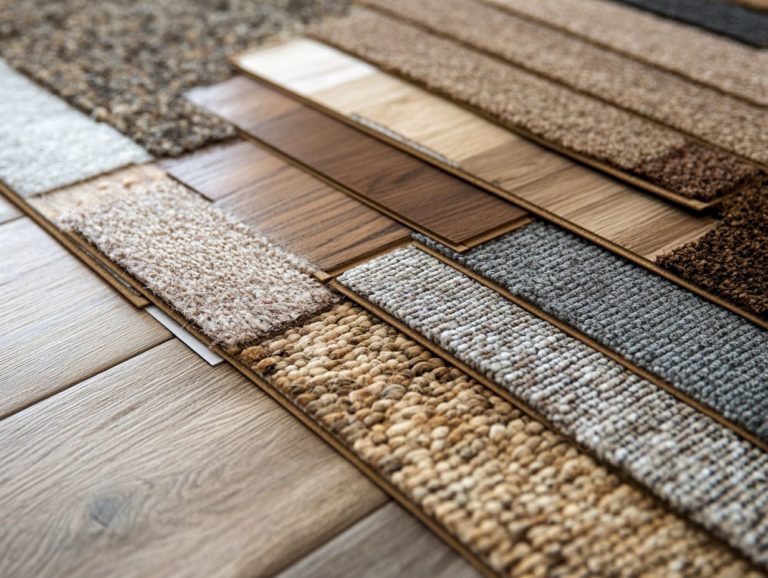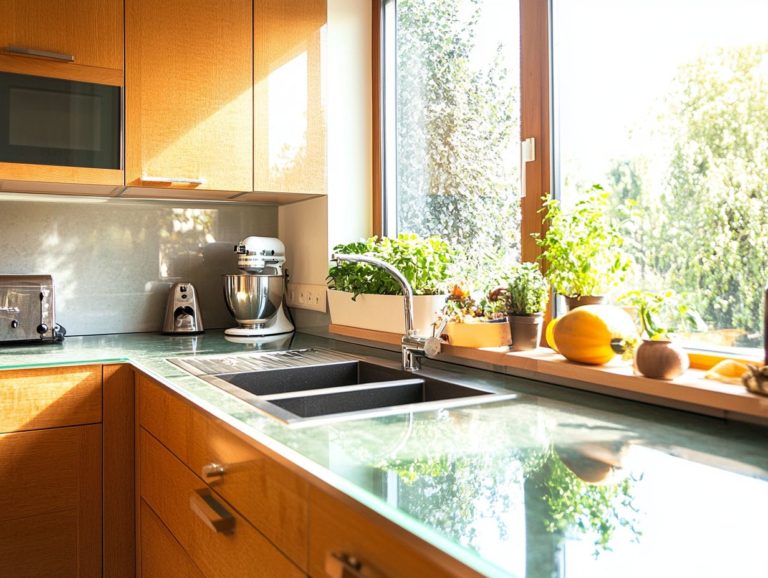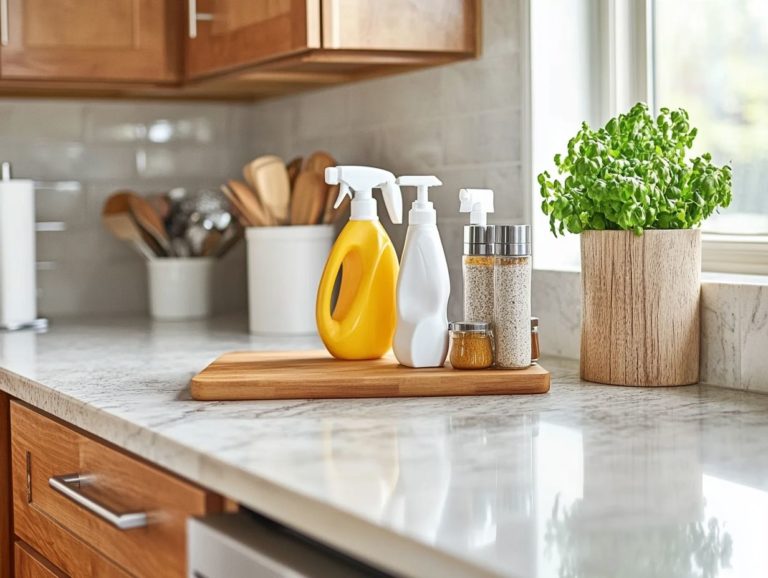5 Creative Uses for Leftover Kitchen Materials
Have you ever considered the untapped potential lurking in your kitchen scraps? Instead of discarding those leftovers, why not transform them into something valuable and sustainable?
This article unveils five inventive ways to repurpose everyday kitchen materials. From converting vegetable scraps into a rich, flavorful broth to crafting all-natural cleaners from citrus peels, these ideas are sure to inspire.
Not only do these solutions help you save money, but they also contribute to a more eco-friendly lifestyle. Get excited and dive into these creative ideas!
Contents
- Key Takeaways:
- 1. Turn Vegetable Scraps into Homemade Broth
- 2. Use Citrus Peels to Make All-Purpose Cleaner
- 3. Create Natural Dyes from Fruits and Vegetables
- 4. Make Homemade Beauty Products with Kitchen Ingredients
- 5. Repurpose Glass Jars for Storage and Organization
- What Are the Benefits of Reusing Kitchen Materials?
- Frequently Asked Questions
Key Takeaways:
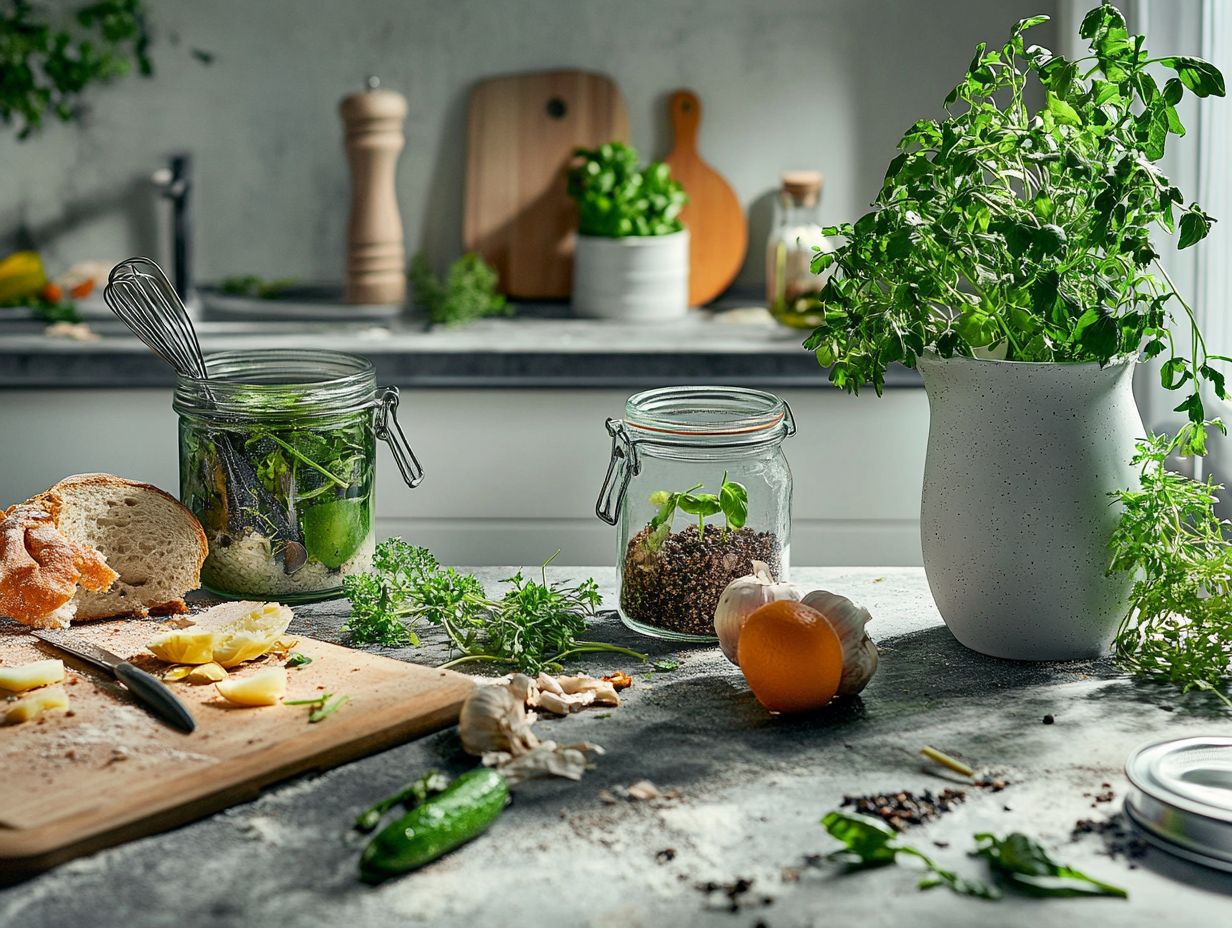
- Transform kitchen scraps into homemade broth, cleaners, and dyes.
- Repurpose jars for storage and organization.
- Help the environment by reducing waste.
1. Turn Vegetable Scraps into Homemade Broth
Transforming vegetable scraps into homemade broth is a brilliant way to reduce waste while elevating your culinary creations. It beautifully embodies the sustainable living ethos that resonates in today’s kitchens.
Collect leftover peels, stems, and other vegetable trimmings to craft a flavorful base for soups, stews, and sauces. This method infuses your dishes with rich, natural flavors while minimizing food waste, aligning seamlessly with a more sustainable lifestyle.
When making your homemade broth, remember to include a variety of vegetables such as onions, carrots, and celery. This mix ensures a well-rounded flavor profile that delights the palate.
After brewing your broth, store it in airtight containers in the refrigerator for up to a week or freeze it in ice cube trays for easy portions. This thoughtful approach guarantees that every bit of the vegetables is utilized, demonstrating your commitment to exceptional taste and sustainability.
2. Use Citrus Peels to Make All-Purpose Cleaner
Utilizing citrus peels to craft an all-purpose cleaner is a brilliant DIY solution that streamlines kitchen cleanup while tapping into the natural antibacterial properties of citrus.
This effective method significantly reduces waste from fruit consumption. Transform what would typically end up in the trash into a highly effective cleaning agent.
To create this cleaner, gather citrus peels from fruits like oranges, lemons, or grapefruits. Soak the peels in vinegar for about two weeks, allowing the essential oils to mix in and create a potent mixture.
Once the soaking period ends, strain the liquid and dilute it with water for use on various surfaces. This homemade solution disinfects and leaves behind a refreshing aroma, elevating your cleaning experience.
For a thorough kitchen cleanup, leverage baking soda as a gentle scrub for stubborn stains, ensuring your space sparkles and invites.
3. Create Natural Dyes from Fruits and Vegetables
Creating natural dyes from fruits and vegetables is an innovative DIY project that allows you to unleash your creativity while championing eco-friendly crafting. By using organic materials that might otherwise become waste, you’re not just making art; you’re making a statement.
Select vibrant produce like beets, avocados, spinach, and turmeric—each offers a unique palette of colors just waiting to be explored. Once you’ve gathered your ingredients, chop or mash them to release their rich hues, then simmer them in water to create a dye bath.
After straining, immerse natural fabrics such as cotton or wool and watch as they transform into stunning shades.
This method yields exquisite, one-of-a-kind colors perfect for textiles and art projects while promoting sustainable practices. You minimize waste and reduce reliance on synthetic chemicals, crafting while caring for the planet.
4. Make Homemade Beauty Products with Kitchen Ingredients
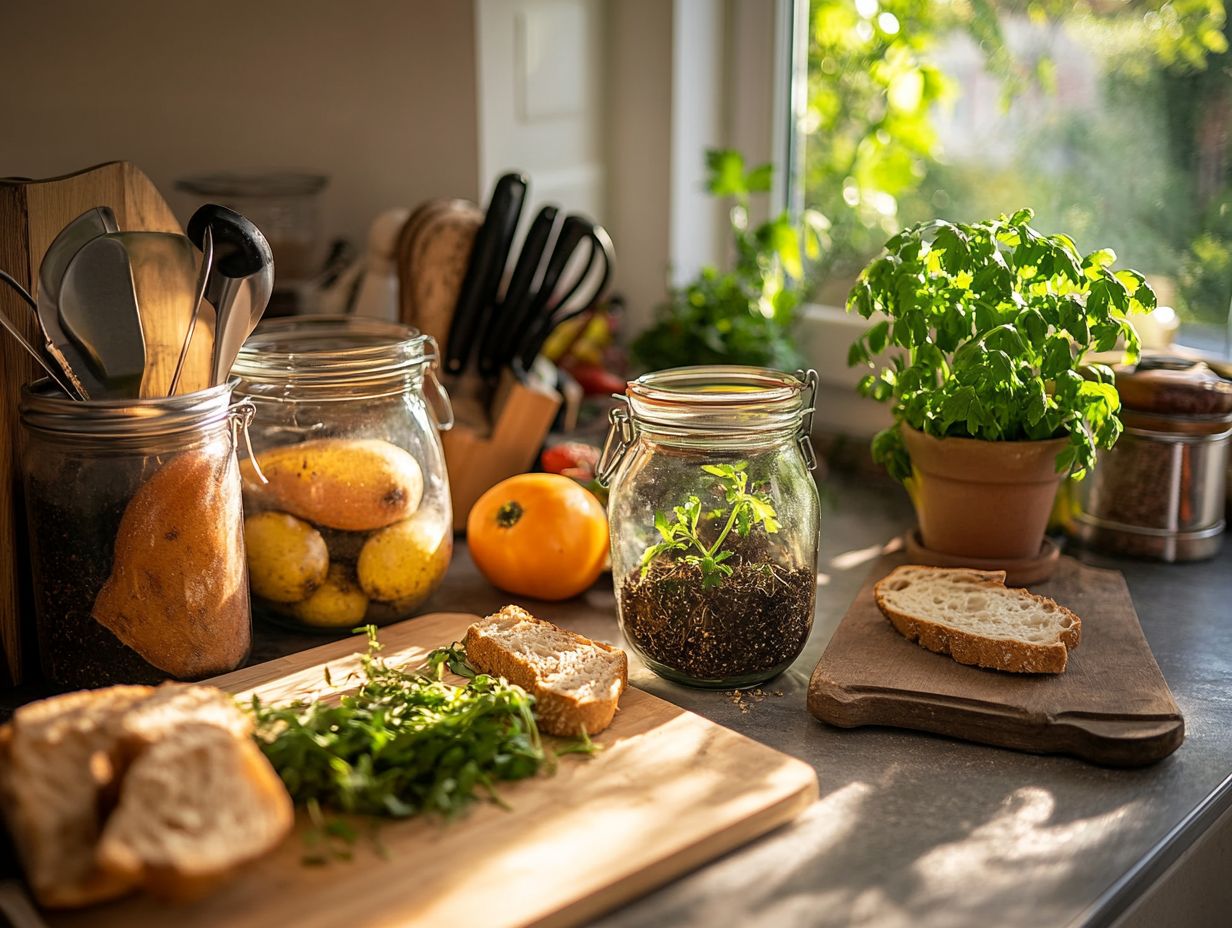
Crafting beauty products from kitchen ingredients is rewarding. You’ll love how it nurtures your skin and supports eco-friendly living!
With staples like honey, oats, and yogurt, you can create customized face masks and scrubs perfect for your skin type.
- Honey acts as a moisture attractor, drawing hydration into your skin. Oats provide gentle exfoliation, ideal for sensitive skin.
- Yogurt brightens and smooths your complexion thanks to its lactic acid.
This practice enhances your skin’s health while reducing waste. Most ingredients are available at home, promoting a sustainable lifestyle devoid of excessive packaging and synthetic additives.
5. Repurpose Glass Jars for Storage and Organization
Repurposing glass jars for storage and organization is a great way to declutter your kitchen. You’re giving new life to items that might otherwise be discarded.
These versatile containers can serve many purposes. Imagine storing dry goods like pasta, grains, and spices—everything neatly organized, easily accessible, and visually appealing.
If you enjoy crafting, these jars can help you organize buttons, beads, and other small supplies. This makes your projects not only more enjoyable but also more efficient.
By choosing to repurpose glass jars, you actively contribute to waste reduction while enhancing the aesthetic appeal of your spaces. A neatly arranged collection of jars can add charm, transforming clutter into a delightful display.
What Are the Benefits of Reusing Kitchen Materials?
Reusing kitchen materials offers a wealth of benefits. You can significantly reduce waste and save money while promoting sustainable living practices that enhance your environment.
Beyond these advantages, these practices spark creativity. You can turn everyday items into something both useful and beautiful.
- For instance, glass jars can be stylish storage containers for spices or herbs.
- Old kitchen towels can be sewn into eco-friendly tote bags.
- Wooden crates can become trendy shelving units, adding charm to your decor while minimizing the need for new materials.
These examples showcase the versatility of used kitchen items. They nurture a deeper appreciation for resources and encourage mindful consumption.
How Can Reusing Kitchen Materials Help the Environment?
Reusing kitchen materials is not just a trend; it’s essential for environmental conservation. By minimizing waste and reducing the carbon footprint linked to production, you contribute to sustainable practices that benefit our planet.
Consider this: the average household generates over 1,000 pounds of waste annually, with a significant portion stemming from kitchen activities. Food and packaging waste are major contributors to landfills, where they break down and emit harmful greenhouse gases.
Implement strategies like repurposing jars for storage, composting organic scraps, or creating your own cleaning solutions. You can dramatically reduce your environmental impact. A recent study revealed that if every kitchen embraced these simple reuse techniques, the collective waste reduction could be akin to removing millions of cars from the road.
This highlights the importance of making mindful choices in your daily kitchen habits. Act now to make a difference!
Try these ideas today and transform your space!
What Are Some Other Creative Uses for Leftover Kitchen Materials?
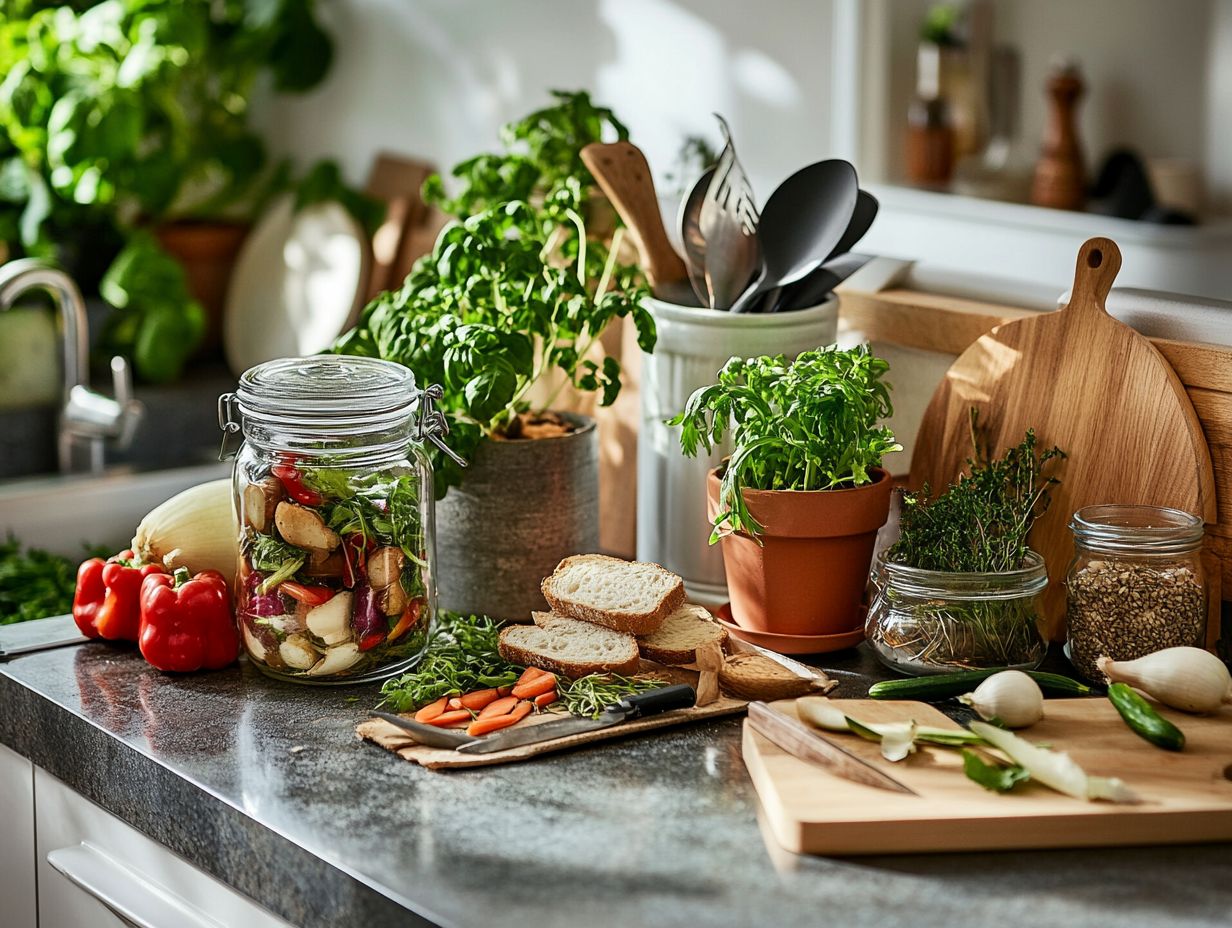
Exploring creative uses for leftover kitchen materials opens up a realm of DIY possibilities. You can turn old items into stylish and functional pieces for your home.
Imagine transforming an old baking pan into a vibrant message board with colorful magnets. Or, repurpose rusty utensils into whimsical garden art. The options are truly limitless!
Get creative with wine corks to craft unique coasters or a charming bulletin board. These simple items can add distinct character to your space. You can also paint glass jars and repurpose them into chic storage containers, providing a fashionable solution for organizing small items.
These clever ideas minimize waste and highlight your ingenuity, demonstrating that creativity knows no bounds when crafting with what you already possess.
How Can One Get Started with Reusing Kitchen Materials?
Getting started with reusing kitchen materials requires a delightful blend of creativity and resourcefulness. This commitment to eco-friendly practices allows you to uncover innovative ways to transform everyday items into something fresh and functional.
Begin by evaluating the space where these items are stored. Look for containers, jars, or old utensils that might have outlived their original purposes. Old cutting boards can be transformed into unique wall art or charming plant stands!
Engaging in local workshops or diving into online communities can spark your creativity. You’ll find a treasure trove of additional ideas! Framing this practice with a sustainability mindset motivates you to continuously seek new ways to reduce waste and positively impact your environment.
What Are Some Common Misconceptions About Reusing Kitchen Materials?
Common misconceptions about reusing kitchen materials can hold you back from diving into DIY projects. You might think that repurposing is time-consuming or requires extensive crafting skills.
In reality, many simple projects can be completed in under an hour with just a few basic tools and a spark of creativity!
Picture this: transforming an old mason jar into a charming candle holder or converting wooden pallets into stylish garden furniture—both achievable with minimal effort and cost.
The magic of these DIY ventures lies in their accessibility. Even if you don’t have a crafting background, success is within reach.
These projects help reduce waste and cultivate confidence and resourcefulness. They encourage you to roll up your sleeves and give it a go!
How Can One Encourage Others to Reuse Kitchen Materials?
Encouraging others to reuse kitchen materials cultivates a vibrant sense of community while championing sustainable living practices. This collective effort paves the way for meaningful advancements in waste reduction and resourcefulness.
By sharing innovative DIY project ideas, you inspire those around you to view everyday items through a fresh lens. Organizing crafting sessions offers a hands-on experience where family and friends can gather to transform what might be considered waste into functional or decorative treasures.
Discussing the environmental benefits—like reducing landfill waste and conserving precious resources—can further ignite participation. Highlighting your personal successes or the positive ripple effects of these practices creates enthusiasm and commitment, turning sustainability into a shared mission within your community.
Frequently Asked Questions
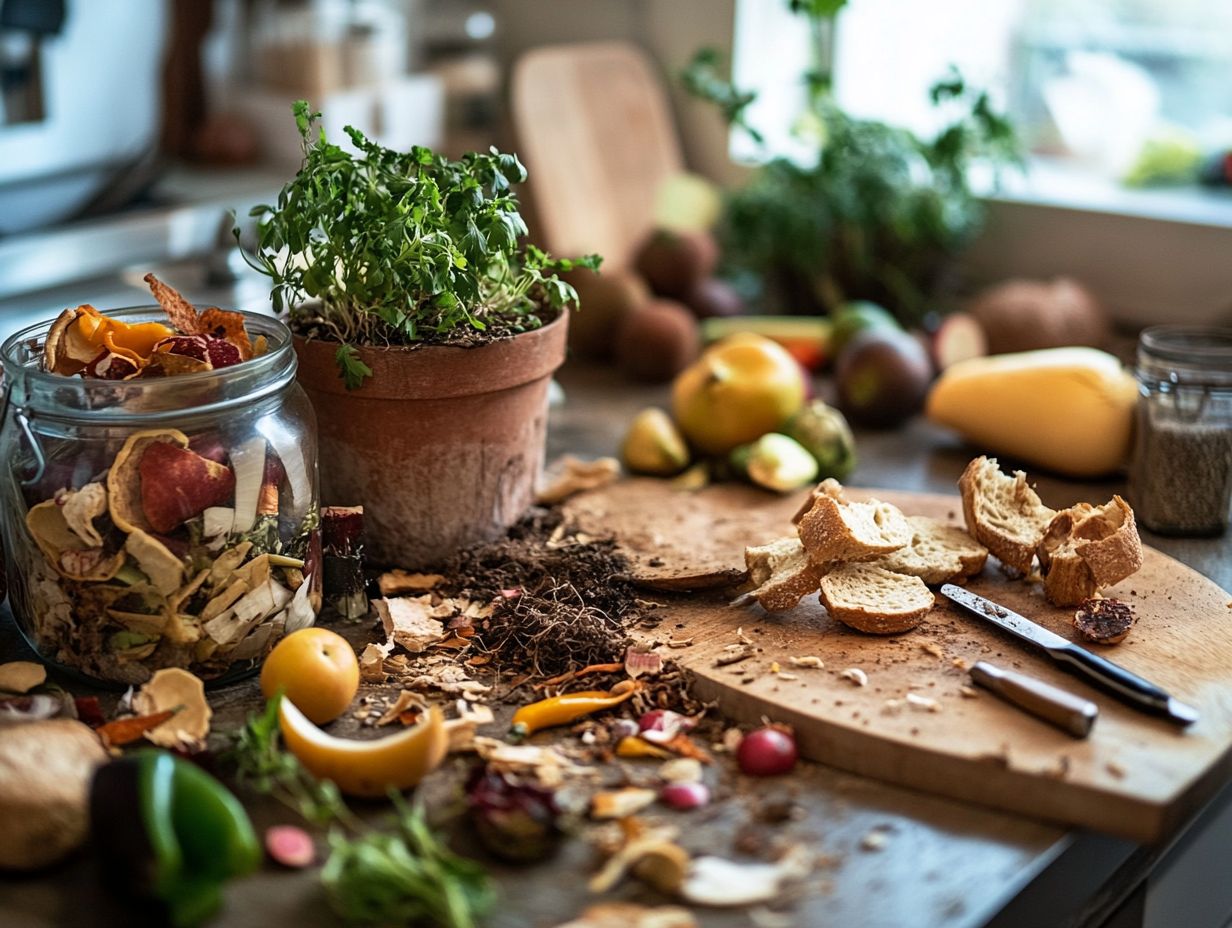
1. Can I use leftover coffee grounds for anything other than making coffee?
Absolutely! Leftover coffee grounds can work wonders around your home. They can be used as a natural fertilizer for plants, a natural dye for fabrics or paper, and an exfoliating scrub for your skin.
Start your journey of creativity and sustainability today—let’s make waste a thing of the past!
2. How can I use eggshells in creative ways?
Eggshells are incredibly useful! Crush them for a calcium boost for your plants or use them as a natural pest repellent in your garden.
You can even clean your kitchen sink and pots with them. Get creative and put those eggshells to work!
3. What can I do with leftover fruit peels?
Yes! Fruit peels can be used in many fun ways. Make a natural cleaner by steeping citrus peels in white vinegar, or use banana peels to fertilize your plants.
You can also bake apple peels with cinnamon and sugar for a tasty snack. Try it out and reduce waste!
4. How can I use leftover wine?
Leftover wine is a fantastic flavor booster! Use it to create a delicious pan sauce for meats, enhance pasta dishes, or make a flavorful marinade for grilling.
Get creative in the kitchen and enjoy your meals even more!
5. What can I do with leftover bread?
Bread can be transformed in so many ways! Make delicious bread pudding, use it for bread crumbs, or turn stale bread into a savory French toast casserole.
You can also create tasty bruschetta or a panzanella salad. Don’t let that bread go to waste—get cooking!
6. Can I use leftover vegetable scraps?
Absolutely! Vegetable scraps are perfect for making homemade broth or a flavorful soup base. Blend them into a nutrient-rich smoothie, or create a flavorful vegetable stock for your recipes.
Get creative and make the most of your leftovers!

